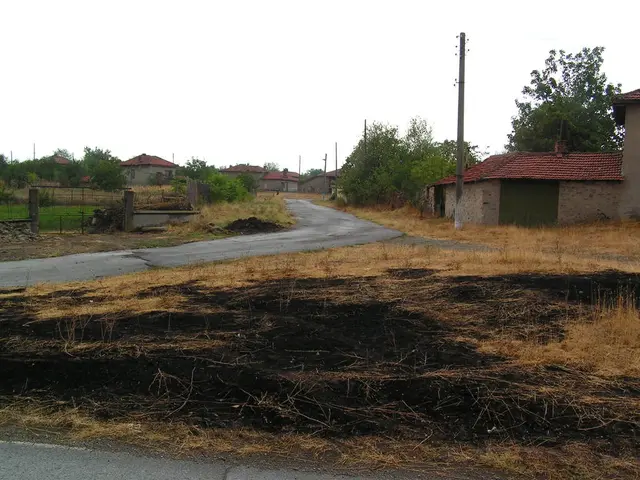Aerial Exploration: Components, Fundamentals, Thrilling Flight Locales
Hot Air Ballooning: An Astonishing Adventure!
Ever since the Montgolfier Brothers dared to defy gravity, hot air balloons have been a marvel of aviation. These vintage wonders, still holding their charm, are mainly used for touristic expedition nowadays, offering an experience that's nothing short of spectacular. So, buckle up as we delve into the world of hot air balloons, exploring their components, the science behind their flight, and the most exhilarating locations to take a flight.
The Anatomy of a Hot Air Balloon
Let's break down the balloon and examine its parts.
- Basket: This is the carrier of the passengers and cargo, normally made from lightweight materials like aluminum, rattan, or woven wicker.
- Burner: Think of it as the jet engine for a jumbo jet like the A330. It gasifies liquid propane, and the resulting mixture of propane and air is ignited, sending flames out through the envelope's mouth.
- Envelope: This is the massive fabric part that's filled with hot air. Modern balloons use envelopes made from nylon or polyester-based materials. They're quite large, and we'll explain why in the next section. At the top of the envelope, you'll find a parachute valve.
- Parachute Valve: This is located at the envelope's top and serves as a large hole for deflating the balloon during landing. A pilot uses a parachute valve cord to gently descend the balloon.
- Gas/ Propane Cylinders: These are stored in the basket and serve as fuel tanks, containing propane gas for the burner.
- Gores: These are fabric parts that, when assembled, create the envelope.
The Science Behind Hot Air Balloons
At the heart of every balloon's movement is a force that combats gravity. For balloons, that force is the hot air rising through the cooler air. Hot air is lighter than cool air because it has less mass per unit of volume. In simpler terms, heating one cubic foot of air by 100 degrees reduces its weight by 7 grams. To lift a Mass of 100 pounds, you'll need approximately 6,500 cubic feet of hot air (heated by 100 degrees).
When the internal air's weight is less than the weights of the basket and the payload when compared to the air outside, the balloon begins to rise. To descend, a pilot uses the parachute valve cord to release hot air from the envelope, decreasing the mass difference between the inside and outside air, causing the balloon to fall.
Picture-Perfect Ballooning Destinations
Now that we've delved into the technicalities, let's embark on a journey to some breathtaking locations for balloon flights:
- Cappadocia, Turkey: This region is a hot air balloonist's dream, with its surreal landscapes, fairy chimneys, and ancient cave dwellings. Sunrise flights offer a breathtaking kaleidoscope of colors[1][2][4].
- Barcelona, Spain: A perfect balloon flight offers an unparalleled view of Barcelona's horizon, showcasing the city's diverse natural landscapes and ecosystems[4].
- Serengeti, Africa: Imagine floating above a sea of wildlife in this wilderness region. It's an unforgettable experience that will take your breath away[5].
- Teotihuacán, Mexico: You can soar over ancient pyramids at sunrise, merging history and jaw-dropping views. It's the only place in the world where you can fly above a UNESCO World Heritage site during a hot air balloon ride[2][3].
The Cultural Impact of Hot Air Balloons
In various parts of the world, hot air balloons hold significant cultural importance, symbolizing freedom, celebration, and harmony with nature. Key regions include:
- Turkey: In Cappadocia, balloons have become cultural icons, representing the region's unique landscapes and drawing tourists worldwide. Festivals often celebrate their role in promoting exploration and tourism.
- USA: Albuquerque, New Mexico celebrates innovation, community, and tradition through the Albuquerque International Balloon Fiesta, an annual event featuring breathtaking "Mass Ascensions" of balloons[6].
- Myanmar: The Taunggyi Balloon Festival features elaborately designed balloons launched as spiritual offerings during the Tazaungdaing festival, symbolizing good fortune and harmony.
- France: As the birthplace of hot air ballooning, France honors its pioneering legacy with events celebrating the Montgolfier brothers' first flight in 1783.
- East Africa: In Kenya and Tanzania, hot air balloon safaris symbolize harmony between humans and nature, combining tourism with eco-conscious cultural preservation[5].
Across these regions, hot air balloons reflect humanity's enduring spirit of adventure and cultural celebration.
For more captivating stories on travel and adventure, click here.
Sources:1. The Culture of Hot Air Ballooning in Cappadocia, Turkey2. Hot Air Balloon Adventures3. Teotihuacán Balloon Rides4. Serengeti Balloon Safari: The Ultimate African Adventure5. Top Destinations for Hot Air Balloon Rides6. Albuquerque International Balloon Fiesta
Attaching hot air ballooning to one's lifestyle is a nod to the modern traveler who embraces adventure, history, and cultural richness. With a hot air balloon ride, you can experience the enchanting vistas of Cappadocia, Turkey, as well as explore Barcelona, Spain's diverse landscapes, all while embracing the thrill of sports and paying homage to aviation history. In addition to these locations, witnessing the promise of new beginnings by soaring over ancient pyramids in Teotihuacán, Mexico, or taking a serene safari flight across the wild Serengeti, Africa, will further enhance your understanding of the cultural impact this unique mode of transport holds.





